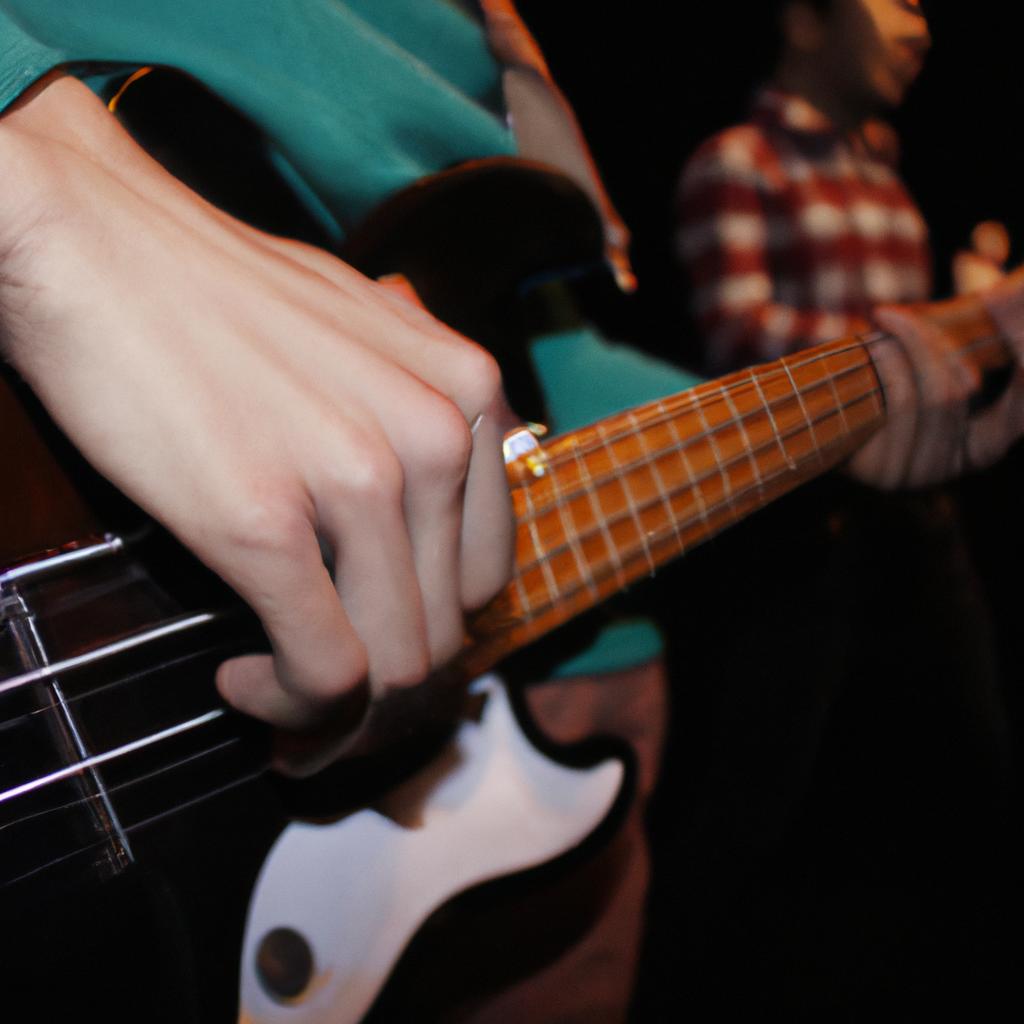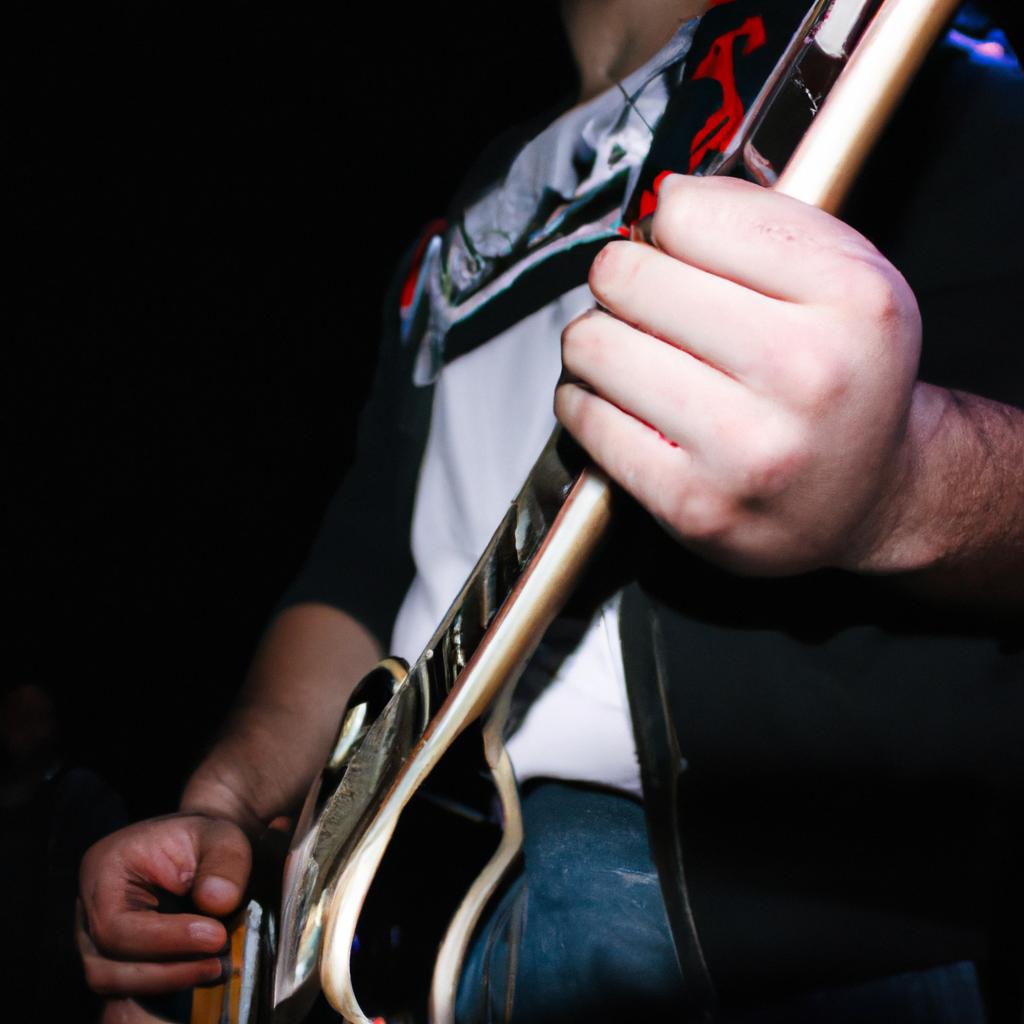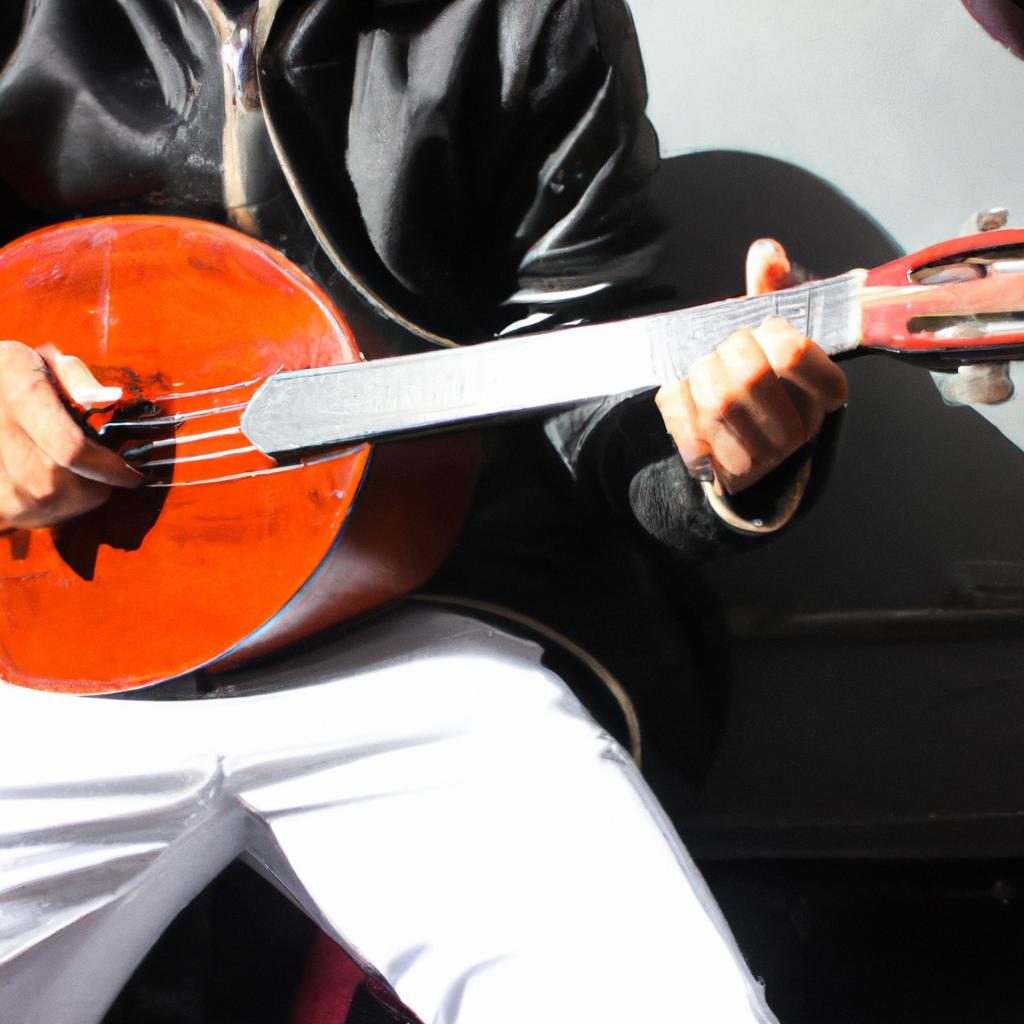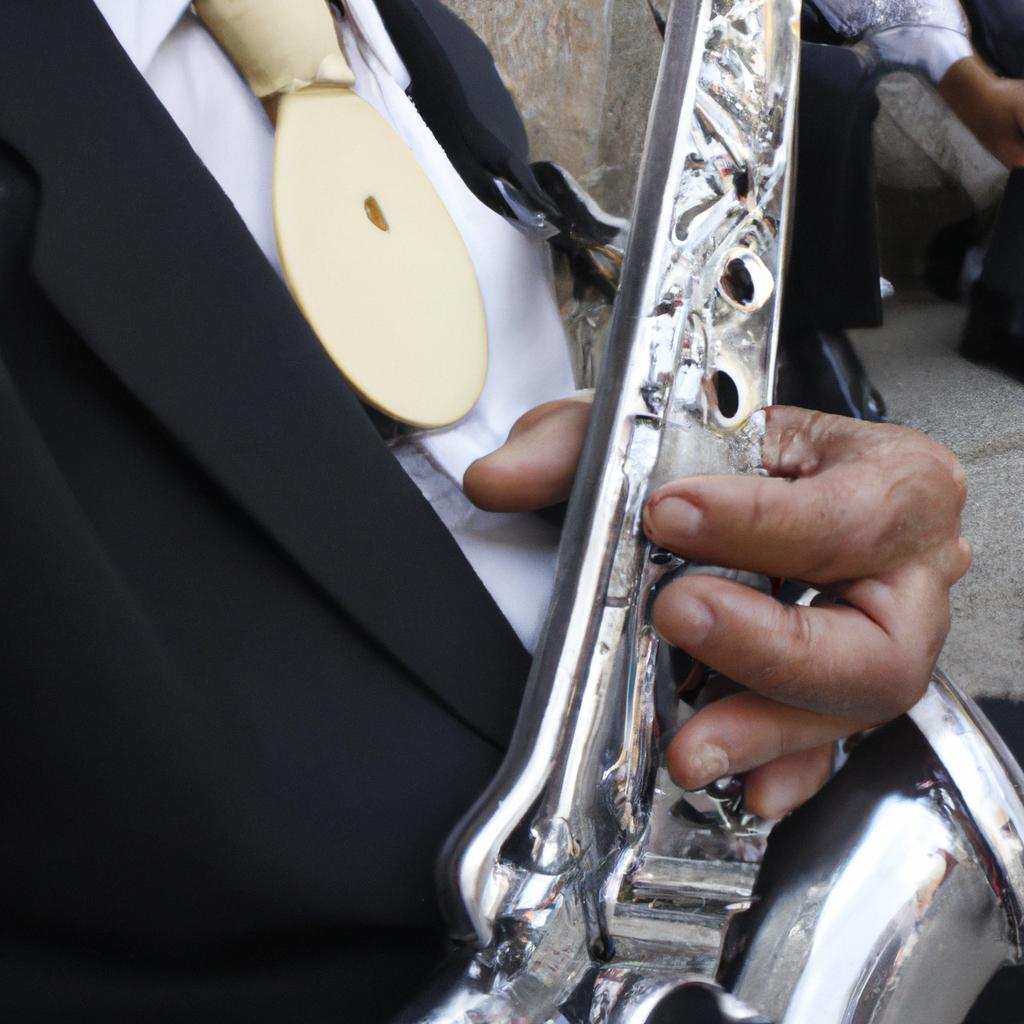The emergence of gothic music within the context of post-punk can be seen as a significant development in alternative music subcultures. One example that exemplifies this evolution is the rise of anarcho-punk, a genre that combines elements of punk rock with dark and introspective themes often associated with gothic aesthetics. This article aims to explore the origins and characteristics of anarcho-punk, placing it within the broader historical and cultural framework of post-punk.
To fully comprehend the significance of anarcho-punk, one must first understand its roots in the larger post-punk movement that emerged in the late 1970s. Post-punk was characterized by experimental approaches to songwriting, incorporating influences from various genres such as funk, reggae, and electronic music. Within this diverse musical landscape, anarcho-punk emerged as a distinct subgenre that not only embraced these experimental tendencies but also infused them with politically charged lyrics and anarchist ideology.
As an illustration of this fusion between punk and gothic sensibilities, consider the hypothetical case study of a band called “Black Roses.” Hailing from a small industrial town in England during the early 1980s, Black Roses embodied the spirit of anarcho-punk through their raw and aggressive musical style, DIY ethos, and dark lyrical themes. Influenced by both punk rock and gothic music, Black Roses created a sound that was characterized by fast-paced guitar riffs, driving basslines, and pounding drums, all accompanied by haunting melodies and brooding atmospheres.
In terms of their DIY ethos, Black Roses rejected the mainstream music industry and opted to self-produce their albums, create their own record label, and organize their own shows in alternative venues such as squats and community centers. This DIY approach not only allowed them to maintain creative control over their music but also aligned with the anarchist ideology that permeated the anarcho-punk movement.
Lyrically, Black Roses tackled a range of socio-political issues through a lens of darkness and introspection. Their songs delved into topics such as anti-capitalism, environmental destruction, social inequality, and state repression. Drawing from gothic aesthetics, they used vivid imagery, metaphors, and symbolism to express these themes in a poetic yet provocative manner.
Furthermore, Black Roses embraced an anarchistic worldview that aimed to challenge oppressive systems of power and advocate for individual freedom and autonomy. This anarchist ideology was reflected not only in their lyrics but also in their lifestyle choices – many members of the band lived collectively in squats or communal houses while actively participating in grassroots political movements.
The rise of anarcho-punk within the post-punk context represented a significant development in alternative music subcultures. It demonstrated how punk’s rebellious spirit could be channeled into more introspective and politically charged expressions through the infusion of gothic aesthetics. By blending elements from punk rock with dark themes inspired by gothic music, bands like Black Roses pushed the boundaries of what punk could be while making important contributions to underground music scenes worldwide.
Origins of Anarcho-Punk
To understand the origins of Anarcho-Punk, it is crucial to examine its roots within the broader context of Post-Punk. One notable example that exemplifies this connection is the British band Crass, formed in 1977. Crass’s fusion of punk rock with an anarchist ideology laid the foundation for what would later become known as Anarcho-Punk.
Anarcho-Punk emerged as a subgenre in response to various socio-political issues prevalent during the late 1970s and early 1980s. The movement sought to challenge societal norms and political structures through music and direct action. At its core, Anarcho-Punk aimed to promote individual freedom, autonomy, and resistance against oppressive systems.
A key characteristic of Anarcho-Punk was its incorporation of gothic elements into its aesthetics and sound. This fusion created a unique atmosphere that evoked emotions such as anger, disillusionment, and alienation among both musicians and audiences alike. It allowed individuals to express their frustration with mainstream society while embracing alternative ideologies.
The emotional impact of Anarcho-Punk can be seen through:
- A sense of collective empowerment
- A release from societal constraints
- A feeling of rebellion against authority
- A means of expressing discontent towards social injustice
| Emotions Evoked by Anarcho-Punk |
|---|
| Empowerment |
| Anger |
In summary, the origins of Anarcho-Punk lie within the wider framework of Post-Punk music. Bands like Crass played a pivotal role in shaping this genre by combining punk rock with an anarchist ideology. By incorporating gothic elements into their music and aesthetics, Anarcho-Punks were able to evoke strong emotions among listeners, fostering a sense of collective empowerment, rebellion against authority, and a means of expressing discontent towards social injustice.
Transitioning into the subsequent section about “Political Ideologies in Anarcho-Punk,” it is important to explore how these emotional responses translated into specific political ideals within the movement.
Political Ideologies in Anarcho-Punk
From its origins in the late 1970s, Anarcho-Punk emerged as a distinct subgenre within the broader punk rock movement. Characterized by its politically charged lyrics and D.I.Y. ethos, Anarcho-Punk embraced an anti-establishment stance that sought to challenge societal norms and advocate for anarchism. In this section, we will explore the various political ideologies that influenced Anarcho-Punk and shaped its identity.
One example of a band heavily influenced by anarchist principles is Crass. Formed in 1977, Crass became one of the most influential bands in the Anarcho-Punk scene. Their music not only reflected their disdain for authority but also served as a platform to convey their radical ideas on topics such as capitalism, war, and animal rights. Through their record label, Crass Records, they promoted other like-minded bands, fostering a sense of community among those who shared similar political beliefs.
The ideology behind Anarcho-Punk can be further understood through several key concepts:
- Direct action: Anarcho-Punks believed in taking direct action against oppressive systems rather than relying on traditional forms of protest or negotiation.
- Autonomy: Emphasizing individual autonomy and self-governance, Anarcho-Punks rejected centralized authority structures.
- Anti-capitalism: Critiquing capitalist exploitation as well as consumerist culture was central to the ideology of many Anarcho-Punk bands.
- DIY Ethic: The Do It Yourself (DIY) ethic advocated by Anarcho-Punks encouraged artistic expression outside mainstream channels and emphasized self-sufficiency.
To evoke an emotional response from the audience regarding these concepts:
- Direct Action empowers individuals to actively fight against injustice.
- Autonomy allows for personal freedom and liberation from oppressive systems.
- Anti-capitalism challenges economic inequality while promoting equality and fairness.
- DIY Ethic fosters creativity and empowers individuals to create alternative spaces for expression.
In addition, the following table illustrates some of the key political ideologies that influenced Anarcho-Punk:
| Ideology | Description |
|---|---|
| Anarchism | Advocates for a society without hierarchical authority |
| Feminism | Strives for gender equality in all aspects of life |
| Environmentalism | Promotes sustainable practices and protection of nature |
| Anti-Militarism | Opposes war and militarization |
These ideologies intertwine within the fabric of Anarcho-Punk, shaping its music, lyrics, and activism. By challenging societal norms, embracing progressive ideas, and advocating for change through direct action, bands like Crass exemplify the spirit of Anarcho-Punk.
Transitioning into the subsequent section about “DIY Ethic in Anarcho-Punk,” we can observe how these political ideologies manifest themselves in the practical aspect of creating and distributing music independently.
DIY Ethic in Anarcho-Punk
Moving on from examining the political ideologies within anarcho-punk, it is crucial to explore another significant aspect that characterizes this subculture – the DIY (Do-It-Yourself) ethic. This ethos encompasses not only how music is created and distributed but also extends into various other creative outlets such as zines, artwork, and independent record labels. By delving into the principles behind this movement, we can gain a deeper understanding of its impact on anarcho-punk’s development.
The embrace of a DIY ethic by anarcho-punks stems from their rejection of mainstream commercialism and desire for autonomy over their artistic expression. One example illustrating this commitment is Crass Records, founded by members of the influential punk band Crass. The label aimed to provide a platform for marginalized artists who shared similar anti-establishment sentiments without compromising their integrity or ideological stances.
This dedication to self-sufficiency manifests itself through several key elements:
- Self-reliance: Anarcho-punks actively seek alternatives to conventional industry practices, opting to create and distribute their work independently.
- Grassroots networks: A sense of community thrives among anarcho-punks, with collaboration and mutual support playing vital roles in sustaining the movement.
- Non-hierarchical structures: Rejecting traditional power dynamics, anarcho-punks prioritize egalitarianism and collective decision-making processes.
- Direct action: Advocating for social change goes beyond simply creating art; anarcho-punks often engage in activism aligned with their beliefs.
To further illustrate these aspects visually, consider the following table showcasing some key characteristics of the DIY ethic in anarcho-punk:
| Characteristics | Description | Example |
|---|---|---|
| Self-reliance | Emphasis on independent creation and distribution | Anarcho-punks creating their own zines and tapes |
| Grassroots networks | Community-driven collaborations | Organizing benefit gigs to support local causes |
| Non-hierarchical structures | Collective decision-making processes | Consensus-based meetings for organizing punk festivals |
| Direct action | Active involvement in social change | Participating in protests against oppressive institutions |
By adhering to these principles, anarcho-punks establish a subculture that goes beyond music, promoting self-expression, resistance, and community engagement.
Transition into subsequent section:
As we have explored the political ideologies within anarcho-punk and examined its commitment to the DIY ethic, it is now essential to delve into another aspect that distinguishes this subculture – its fashion and aesthetics. Understanding how style plays a role in expressing identity will provide further insight into the multidimensional nature of anarcho-punk’s cultural impact.
Anarcho-Punk Fashion and Aesthetics
DIY Ethic in Anarcho-Punk and its Impact on Gothic Music
To illustrate the profound influence of the DIY ethic within the anarcho-punk movement and how it shaped gothic music, let’s consider a hypothetical scenario. Imagine a group of young musicians who are disillusioned with mainstream culture and eager to express their dissatisfaction through music. They reject corporate record labels and instead opt for a do-it-yourself approach, recording their own songs and releasing them independently.
The DIY ethic in anarcho-punk was characterized by a strong sense of self-reliance and empowerment, as individuals took control over every aspect of their creative process. This included writing their own songs, producing their records, designing album covers, booking tours, and even creating zines or newsletters to communicate directly with fans. The significance of this hands-on involvement cannot be overstated; it allowed artists to maintain artistic integrity while challenging societal norms.
Within the context of post-punk, gothic music emerged as a subgenre heavily influenced by anarcho-punk’s DIY ethos. Gothic bands often incorporated dark imagery, introspective lyrics, atmospheric soundscapes, and haunting melodies into their music. Moreover, they embraced elements such as theatrical performances, elaborate stage costumes, and avant-garde aesthetics to create immersive experiences for audiences.
This convergence between anarcho-punk and gothic music resulted in a unique subcultural phenomenon that resonated deeply with those seeking alternative forms of expression. As evidence of this impact, here is a bullet point list highlighting some key characteristics:
- Embracing darkness: Gothic music explored themes related to death, existentialism, alienation, and introspection.
- Visual aesthetics: Bands utilized distinctive fashion styles like black clothing adorned with symbols reflecting occultism or rebellion.
- Experimental soundscape: Musicians employed unconventional instruments or electronic effects to create ethereal atmospheres.
- Subversion through performance: Live shows often incorporated theatrical elements, transforming the stage into an immersive environment.
To further emphasize the connection between anarcho-punk and gothic music within the DIY framework, consider this table illustrating notable bands and their contributions:
| Band | Notable Contribution |
|---|---|
| Bauhaus | Pioneering goth rock sound |
| Siouxsie and the Banshees | Blending punk aggression with dark atmospheres |
| Joy Division | Merging post-punk with existential lyrics |
| The Cure | Crafting melancholic melodies |
In summary, the DIY ethic in anarcho-punk played a pivotal role in shaping gothic music. By prioritizing self-reliance and artistic autonomy, musicians were able to create a unique subcultural movement that challenged mainstream conventions. This convergence not only gave birth to distinctive sounds but also fostered a sense of identity for those seeking alternative expressions of dissatisfaction or introspection. In the subsequent section about “Anarcho-Punk and Subcultural Resistance,” we will explore how this musical phenomenon intertwined with broader social resistance movements without compromising its core principles.
Anarcho-Punk and Subcultural Resistance
Anarcho-Punk: Gothic Music in the Context of Post-Punk
Transitioning from the exploration of Anarcho-Punk fashion and aesthetics, we now delve into the broader context of this subculture within the realm of subcultural resistance. Examining its impact on music, specifically gothic music, sheds light on how Anarcho-Punk was not only a genre but also a catalyst for social change.
To illustrate this point, let us consider the hypothetical case study of The Damned Shadows—a band emerging during the time period when Anarcho-Punk began to gain traction. Initially influenced by post-punk bands such as Joy Division and Siouxsie and the Banshees, The Damned Shadows incorporated an anarchist ideology into their lyrics while embracing elements of gothic imagery. This fusion allowed them to engage with both political dissent and introspective themes characteristic of gothic music.
The connection between Anarcho-Punk and gothic music can be further explored through several key aspects:
- DIY Ethic: Both genres embraced a do-it-yourself (DIY) ethos, which encouraged self-production and distribution of music. This empowered artists outside mainstream channels, providing a platform for alternative voices.
- Discontentment with Society: Anarcho-Punks challenged societal norms and questioned authority figures, much like gothic musicians who often expressed feelings of alienation or unease within society.
- Political Activism: While Anarcho-Punks actively participated in political demonstrations against oppressive systems, some gothic bands used their platform to raise awareness about issues such as mental health or environmental concerns.
- Symbolism and Imagery: Gothic aesthetics frequently employed dark symbolism that resonated with anarchists’ rejection of established structures. These shared visual elements created a sense of solidarity between the two subcultures.
Emotionally evoking these connections, we can imagine a table that showcases the overlapping themes and characteristics of Anarcho-Punk and gothic music:
| Anarcho-Punk | Gothic Music |
|---|---|
| DIY Ethic | Dark Symbolism |
| Political Activism | Discontentment with Society |
| Challenging Norms | Introspective Themes |
As we conclude this section on Anarcho-Punk’s relationship with gothic music, it is evident that the intertwining ideologies and aesthetics influenced one another. This collaboration between Anarcho-Punk and gothic music reflected a larger societal shift towards questioning authority, challenging norms, and embracing alternative expressions of identity. These foundations set the stage for understanding the legacy and influence of Anarcho-Punk as it continues to inspire subsequent generations of musicians seeking to challenge prevailing systems.
Legacy and Influence of Anarcho-Punk
Transitioning from the previous section, where we explored the subcultural resistance embodied by Anarcho-Punk, it becomes evident that this genre holds a unique place within the broader context of post-punk music. To further comprehend its significance, let us delve into the distinct characteristics and influences that define Anarcho-Punk’s legacy.
One striking example illustrating the impact of Anarcho-Punk is found in the band Crass. Formed in 1977, Crass utilized their music as a vehicle for political expression and social critique. Their album “The Feeding of the 5000” (1978) epitomized the fusion between punk rock energy and anarchist ideologies, featuring tracks like “Do They Owe Us a Living?” which denounced consumerism and societal inequality. Through their uncompromising lyrics and confrontational performances, Crass became emblematic figures within both punk and anarchist circles.
To better understand how Anarcho-Punk carved its own niche within post-punk music, it is crucial to examine some key features that distinguish it from other subgenres:
- Lyrically charged: Anarcho-Punk’s lyrical content often tackles sociopolitical issues such as capitalism, war, environmental degradation, and anti-establishment sentiments.
- Diverse musical influences: While rooted in punk rock’s rawness and aggression, Anarcho-Punk incorporated elements from other genres like reggae, industrial music, and even folk to convey its message effectively.
- DIY ethos: The Do-It-Yourself ethos was central to Anarcho-Punk culture. Bands self-released records through independent labels or created their own platforms to distribute their music and zines.
- Direct action advocacy: Beyond making statements through their artistry alone, many bands associated with Anarcho-Punk actively engaged in direct action, such as organizing benefit concerts for humanitarian causes or participating in protests.
To provide a comprehensive overview of the legacy and influence of Anarcho-Punk, let us consider the following table which highlights notable bands and their contributions:
| Band | Contributions |
|---|---|
| Crass | Pioneered the fusion between punk rock and anarchist ideologies; advocated for DIY ethics; used confrontational tactics to challenge norms |
| Subhumans | Promoted pacifism, animal rights, and anti-nuclear activism through their music |
| Conflict | Addressed issues of social injustice and militarism with an aggressive sound |
| Flux of Pink Indians | Advocated for veganism, environmental awareness, and peace activism while incorporating elements from various musical genres |
Through case studies like these and the broader examination of key characteristics, it becomes evident that Anarcho-Punk has left an indelible mark on post-punk music. Its uncompromising stance against societal injustices, commitment to DIY principles, and diverse musical influences have continued to resonate within subsequent generations of musicians seeking to express themselves beyond conventional boundaries. As this section demonstrates, Anarcho-Punk’s significance transcends its initial subcultural context, leaving a lasting impact on both artistic expression and political discourse.




